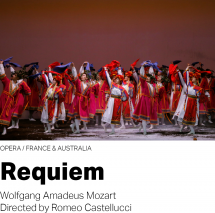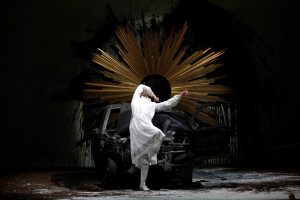Requiem

Adelaide Festival Theatre, Friday 28 February 2020 (Directed and designed by Romeo Castellucci)
Mozart thought he was being poisoned by instalments, so that his death would adjoin completion of the Requiem in D minor (K.626). In other words, he was commissioned by the Next World to write his own funerary music. He was obviously paranoid by then, but the ‘anonymous’ commissioning of the work (by an agent of Count Walsegg, who knocked on Wolfgang’s door), and his own serious illnesses, may have informed the beauty and brilliance of the piece: a hotchpotch to be sure, and an incomplete one, but inspirational nonetheless, despite it not striking the ear as particularly sacred, or ecclesiastical, for a liturgical piece. Yet “[t]he total impression remains. Death is not a terrible vision but a friend.”* Actually, parts of the work bordered on blasphemy, at least at the time, when that was a Thing, but its shining virtue, 229 years on, is the glorious music, the musical structure, and the feeling of re-birth and renewal, that is the hallmark of World Art.

At the Adelaide Festival, these aspects were wonderfully rendered. The Adelaide Symphony Orchestra under Rory Macdonald was magnificent, at its very best. So were the singers: Sara Mingardo, Martin Mitterrutzner, David Greco, and Siobhan Stagg, superbly supported by the Adelaide Festival Chorus. (A list of the main credits is below). This alone would have been sufficient (a few other Mozart liturgicals and incidentals were sprinkled in) but we had the added frisson of staging by Romeo Castellucci, that avatar of the avant-garde, which The Varnished Culture had been dreading a little. Castellucci’s vaunted ‘colossal, pioneering, visceral, revelatory imagination’ struck us as quite earthbound at times (at times, literally), but the overall effect of his work, carried out by spirited dancers with ingenious props and flourishes, was delivered, as promised: “a ritual of life and death, extinction and the possibility of rebirth”, in ways which were satisfying and even moving.
Certainly, we had some quibbles. These reflect upon your reviewer more than the Director, perhaps. Some of the tropes were so obvious as to be trite. For example, the battered black automobile of death (see below) that obliterated the cast, all dressed in white – they bounced artistically off the bonnet, one by one, and laid themselves low in the firmament for a dirt-nap en masse. TVC had a panic-flashback to the disastrous ENO Don Giovanni, complete with clapped-out Ford Consul, rolling onto the stage. (For a moment, it seemed Castellucci was unmasked as Calixto Bieto, only with taste). Dervishes whirling around a maypole may signify the circle of life, of course, but in a requiem mass? And a full-scale disrobing? A troubled lad kicking a skull around (it’s been done)? The projecting of things past (cities, languages, architecture, etc., all commemorated in crisp TimesNewRoman font) to remind us of mortality? A faux Pietà? Pondering such touches, we considered them visually impressive but thematically silly.
Nevertheless, these jarring notes were dissolved in the fluid state of the whole, with the overall effect dreamlike and thought-provoking: The stark opening with an aged lady abed, a nearby discarded orange symbolic of past fertility; the rear wall a backdrop for splashes of colour (by lighting, paint, dirt, and so on) that ultimately tilted to dump its accumulated detritus onto the stage, as would a gravedigger; the dancers in full attire, marching or skipping in formation; gyrating ‘shakers’ spreading dirt artistically across the length and breadth of the earth’s floor, or dancing around lush, verdant fruit trees; and, at finale, though once again rather obvious and derivative, the cute Tot, alone, centre-stage, doubtless forgetting his lines, who closed the circle of the thesis (vide: 2001: A Space Odyssey). At curtain, the Festival first-night crowd of the Great and Good (Our current Premier, the former Premier, Festival Director Armfield, Geoffrey Rush, David Marr, et al) rose almost in unison at this highly impressive meld of old and new. Amadeus, possibly the only Catholic Freemason in the history of Music, would have worn a Heavenly Grin.
CAST & CREW
Conductor Rory Macdonald
Stage Director, Set, Costume and Lighting Designer Romeo Castellucci
Associate Director and Costume Designer Silvia Costa
Dramaturge Piersandra di Matteo
Choreographer Evelin Facchini
Revival Director Josie Daxter
Costume Designer Assistant Elisabeth de Sauverzac
Associate Lighting Designer Marco Giusti
Chorus Master and Associate Conductor Brett Weymark
Image Festival d’Aix-en-Provence 2019 © Pascal Victor
______________________________________________________________
Soprano Siobhan Stagg
Alto Sara Mingardo
Tenor Martin Mitterrutzner
Bass David Greco
Featuring Adelaide Symphony Orchestra, Adelaide Festival Chorus and dancers from Australian Dance Theatre.
[*Einstein, Mozart – His Character; His Work (1946), p. 354.]Leave a comment...
While your email address is required to post a comment, it will NOT be published.



1 Comment